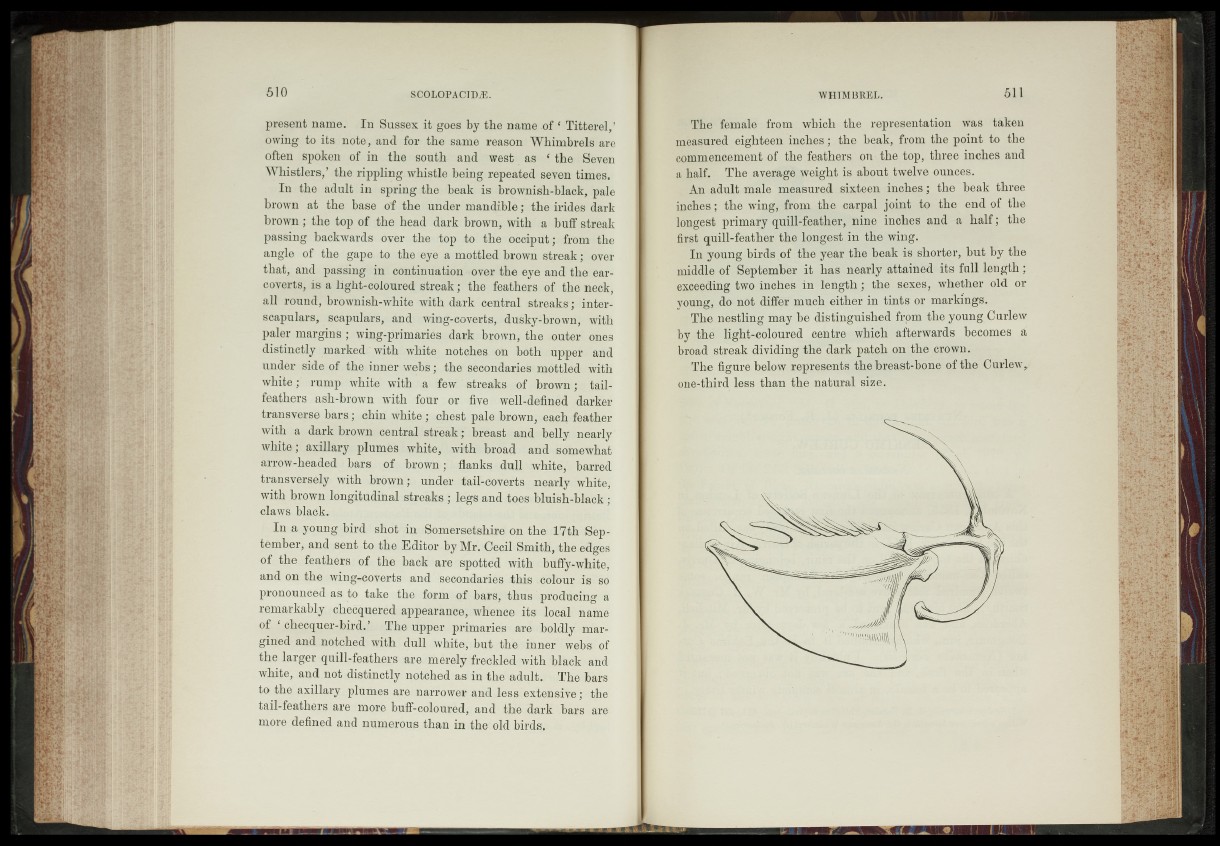
present name. In Sussex it goes by the name of ‘ Titterel,’
owing to its: note, and for the same reason Whimbrels are
often spoken of in the south and west as * the : Seven
Whistlers,’ the rippling.whistle being repeated seven times.
In the adult in spring .the beak is brownish-black, pale
brown at the base of the under mandible; the irides dark
brown ; the top of the head dark brown, with a buff streak
passing backwards over the top to the occiput; from .the
angle of the gape to the eye a mottled brown streak ;^over
that, and passing in continuation -over the eye and the ear-
coverts, is a light-coloured streak; the feathers-of the neck,
all round, brownish-white with dark central streaks; inter-
scapulars, scapulars, and wing-covcrts,;.- duskyJbrown, with
paler margins:; wing-primaries dark brown, the-.outer ones
distinctly marked;" with white notches on both upper - and
under side, of* the-inner webs; the* secondaries mottled- with
white;’ rump’ white with a- -few ' streaks ©f. brown ; * tail-
feathers ash-brown with four or five well-defined darker
transverse bars; c h in j|b it|; - cheat; pale ;brown,. each-- feather
with a dark brown central streak; breast and;?be% nearly
white; axillary plumes awhile/' with- broad and somewhat
arrow-headed - bars ofh. brown-; flanks dull white/i barred
transversely with brown; uhdet tail-covefts-Cinearly, whi|bj
with brown longitudinal streaks,; legs and toes;bluish-black;
claws black.
In a young bird shot/ in .Somersetshire1 on the- I?th September
j. and sent-to the. Editor by Mr-. GecihSmitH, the .edges
of the feathers jq£ the back are spotted with buffy-white,
and on the wing4&overts' and secondaries this .colour is’s'so
pronounced as-to take the form of bars, thus ‘..producing, a
remarkably, M checquered; appearances whence - its- local -name
V slEher: upper |primaries are |boldly §margined
and notched with* dull whiteribut thte,?>ihner webSt of
the larger quill-feathers are^iherelytfreckled-wiifchTblack and
white, and not distinctly notched‘as in-the adults. The bars
to, the axillary plumes are narrower anddass-extehsive; the
tail-feathers >aret-moi*h huff-coloured,jand the dark .bars are
more defined and numerous than in thesold birds.
• ThiA female from which the representation was > taken
measured eighteen inches; the beak, from the point to the
commencement of the feathers, on the top, three inches and
a half. -fghe.average .weight is about, twelve ounces.
An adult male measured, sixteen inches; the beak three
ipches; the wing, from the. carpal joint to the end of the
longest primary quill-feather, nine inches and a half; the
first quill-feather the longest in the wing.
In young birds,of the year the beak is shorter, but;by tbe
middle of September it has nearly attained its full length ;
exceeding two inches in length ; the. sexes, whether ■ old or
young, do not differ mueh either in tifits ©r markings.
;?sThe nestling may he distinguished from the young Curlew
by the hght^eoloured centre which afterwards becomes a
broad streak dividing the dark patch on the crown.
t^The figure represents-.the breast-hone of the Curlew,#
one-third less than the natural silSp®